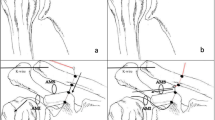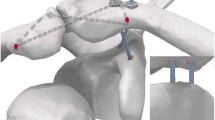Abstract
Background
The arthroscopically assisted Double-TightRope technique has recently been reported to yield good to excellent clinical results in the treatment of acute, high-grade acromioclavicular dislocation. However, the orientation of the transclavicular–transcoracoidal drill holes remains a matter of debate.
Hypothesis
A V-shaped drill hole orientation leads to better clinical and radiologic results and provides a higher vertical and horizontal stability compared to parallel drill hole placement.
Study design
This was a cohort study; level of evidence, 2b.
Methods
Two groups of patients with acute high-grade acromioclavicular joint instability (Rockwood type V) were included in this prospective, non-randomized cohort study. 15 patients (1 female/14 male) with a mean age of 37.7 (18–66) years were treated with a Double-TightRope technique using a V-shaped orientation of the drill holes (group 1). 13 patients (1 female/12 male) with a mean age of 40.9 (21–59) years were treated with a Double-TightRope technique with a parallel drill hole placement (group 2). After 2 years, the final evaluation consisted of a complete physical examination of both shoulders, evaluation of the Subjective Shoulder Value (SSV), Constant Score (CS), Taft Score (TF) and Acromioclavicular Joint Instability Score (ACJI) as well as a radiologic examination including bilateral anteroposterior stress views and bilateral Alexander views.
Results
After a mean follow-up of 2 years, all patients were free of shoulder pain at rest and during daily activities. Range of motion did not differ significantly between both groups (p > 0.05). Patients in group 1 reached on average 92.4 points in the CS, 96.2 % in the SSV, 10.5 points in the TF and 75.9 points in the ACJI. Patients in group 2 scored 90.5 points in the CS, 93.9 % in the SSV, 10.5 points in the TF and 84.5 points in the ACJI (p > 0.05). Radiographically, the coracoclavicular distance was found to be 13.9 mm (group 1) and 13.4 mm (group 2) on the affected side and 9.3 mm (group 1) and 9.4 mm (group 2) on the contralateral side. The distance of neither the affected side nor the contralateral side differed significantly between both groups (p > 0.05). In group 1, eight patients (53 %) and in group 2 four patients (31 %) revealed signs of dynamic posterior instability (p > 0.05). Clavicular drill hole enlargement was found to be equally distributed in group 1, whereas group 2 displayed a cone-shaped form.
Conclusion
The Double-TightRope technique yields good to excellent clinical results in both V-shaped and parallel drill hole placement. Partial recurrent vertical and horizontal instability represents a problem in both techniques. So far, no significant differences regarding clinical or radiologic results have been found. Long-term results are needed to reveal possible advantages in terms of clinical and radiologic acromioclavicular stability.





Similar content being viewed by others
References
Alexander OM (1954) Radiography of the acromioclavicular articulation. Med Radiogr Photogr 30:34–39
Chernchujit B, Tischer T, Imhoff AB (2006) Arthroscopic reconstruction of the acromioclavicular joint disruption: surgical technique and preliminary results. Arch Orthop Trauma Surg 126:575–581
Constant CR, Murley AH (1987) A clinical method of functional assessment of the shoulder. Clin Orthop Relat Res 214:160–164
Elser F, Chernchujit B, Ansah P, Imhoff AB (2005) A new minimally invasive arthroscopic technique for reconstruction of the acromioclavicular joint. Unfallchirurg 108:645–649
Fuchs B, Jost B, Gerber C (2000) Posterior–inferior capsular shift for the treatment of recurrent, voluntary posterior subluxation of the shoulder. J Bone Joint Surg Am 82:16–25
Rios CG, Arciero RA, Mazzocca AD (2007) Anatomy of the clavicle and coracoid process for reconstruction of the coracoclavicular ligaments. Am J Sports Med 35:811–817
Rockwood C (1984) Injuries in the acromioclavicular joint: subluxations and dislocations about the shoulder. In: Rockwood CA Jr, Green DP (eds) Fracture in adults. J B Lippincott, Philadelphia, pp 860–910
Salzmann GM, Walz L, Buchmann S, Glabgly P, Venjakob A, Imhoff AB (2010) Arthroscopically assisted 2-bundle anatomical reduction of acute acromioclavicular joint separations. Am J Sports Med 38:1179–1187
Scheibel M, Droschel S, Gerhardt C, Kraus N (2011) Arthroscopically assisted stabilization of acute high-grade acromioclavicular joint separations. Am J Sports Med 39:1507–1516
Taft TN, Wilson FC, Oglesby JW (1987) Dislocation of the acromioclavicular joint. An end-result study. J Bone Joint Surg Am 69:1045–1051
Walz L, Salzmann GM, Fabbro T, Eichhorn S, Imhoff AB (2008) The anatomic reconstruction of acromioclavicular joint dislocations using 2 TightRope devices: a biomechanical study. Am J Sports Med 36:2398–2406
Wolf EM, Pennington WT (2001) Arthroscopic reconstruction for acromioclavicular joint dislocation. Arthroscopy 17:558–563
Conflict of interest
No potential conflict of interest is declared by all authors.
Author information
Authors and Affiliations
Corresponding author
Additional information
The corresponding author is a consultant for Karl Storz and Arthrex Company.
Rights and permissions
About this article
Cite this article
Kraus, N., Haas, N.P., Scheibel, M. et al. Arthroscopically assisted stabilization of acute high-grade acromioclavicular joint separations in a coracoclavicular Double-TightRope technique: V-shaped versus parallel drill hole orientation. Arch Orthop Trauma Surg 133, 1431–1440 (2013). https://doi.org/10.1007/s00402-013-1804-8
Received:
Published:
Issue Date:
DOI: https://doi.org/10.1007/s00402-013-1804-8




